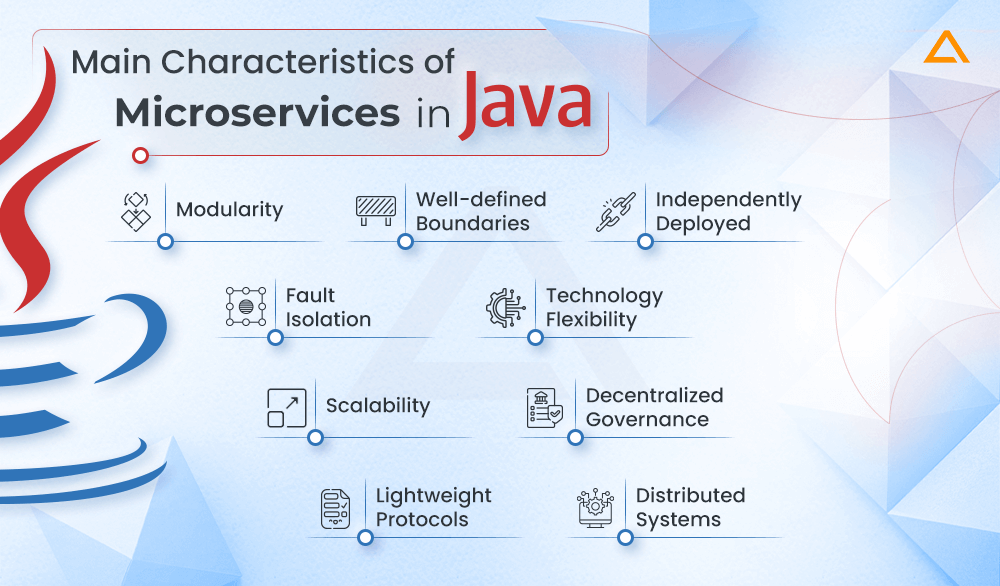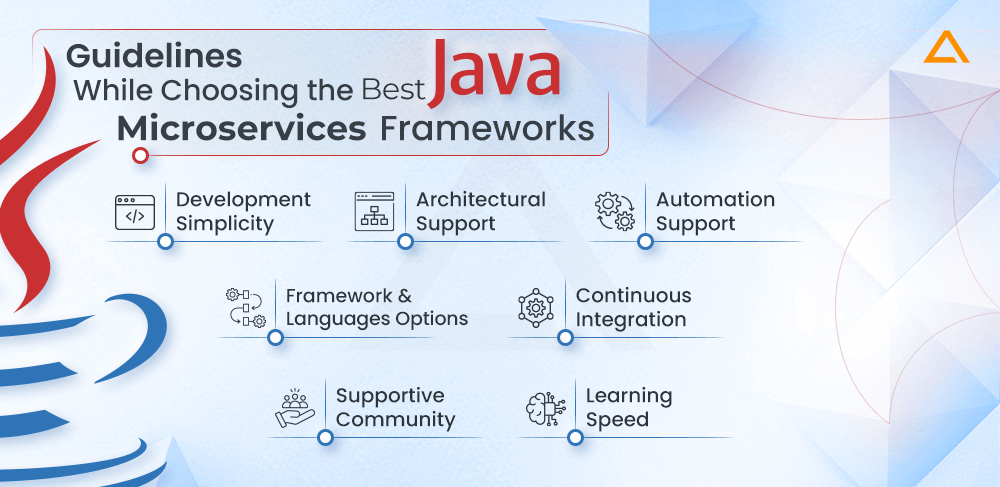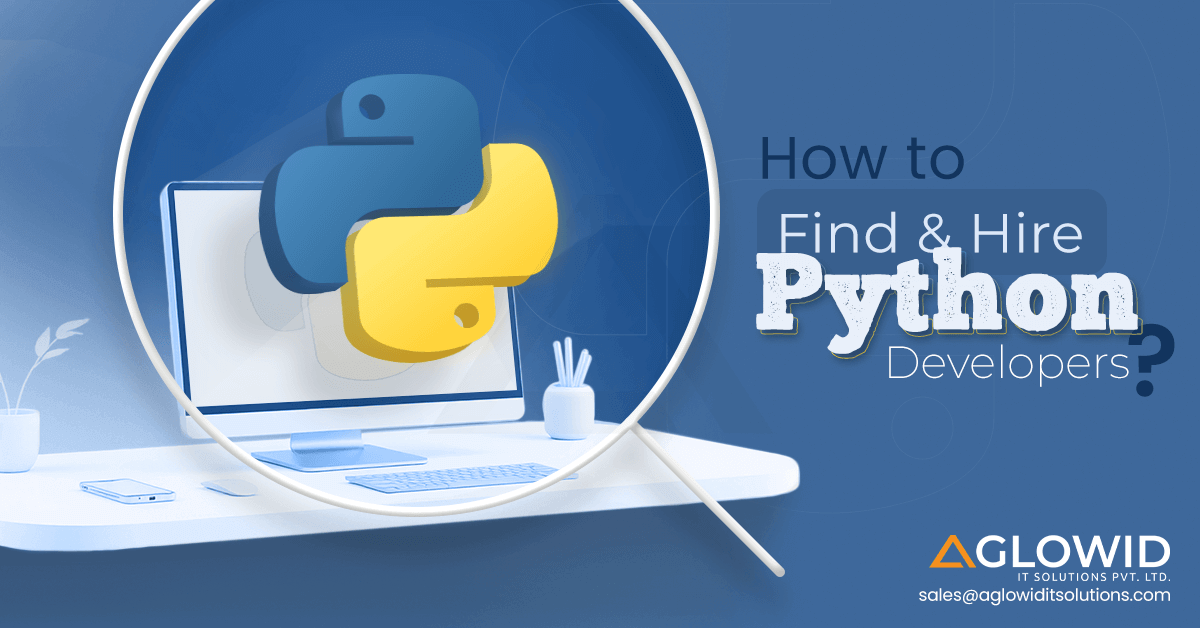Quick Summary:
Are you curious to learn about Java Microservices frameworks, but don’t want to get lost in tech jargon? Well then, you’re at the right place! Imagine these frameworks as powerful tools which helps software developers in developing robust & scalable applications. This comprehensive blog will shed insights on various java microservices.
Let’s dive in!
Microservices architecture is an approach to building large, complex software systems into the small, independent, & manageable services. Each of these services is dedicated to completing a single task & communicates with other services using a lightweight mechanism like HTTP APIs. This method contrasts with the monolithic architecture, which combines all application features into a single codebase.
Some important characteristics of microservices in java are as follows:
- Modularity
- Well-defined boundaries
- Independently deployed
- Fault isolation
- Technology flexibility
- Scalability
- Decentralized governance
- Lightweight protocols
- Distributed systems

Now that you have a fundamental understanding of microservices, let’s understand why using java microservices frameworks.
Why Use Java for Microservices?
Java programming language is popular because of their robust ecosystem, portability, and established libraries and frameworks. Java provides various benefits when it comes to developing microservices:

Platform Independence
Java applications uses Java virtual machine, with which Java applications can operate on a variety of operating systems and are not dependent on a single platform.
Robust Ecosystem
Microservices development can be accelerated by the large ecosystem of Java libraries, tools & frameworks.
Strong Community Support
It’s simple to locate resources & answers due to its vibrant & helpful Java community.
Performance
Java offers competitive performance with the modern JVM implementation & optimization techniques.
Security
Java’s mature security features make it a reliable choice for building secure micro services.
Best Java Microservices Frameworks to use in 2024
Java microservices framework are set of tools, libraries, and conventions that simplify the development, deployment, & management of microservices-based applications. These frameworks provide solutions for common microservices challenges, such as service discovery, communication, configuration management, and monitoring for which we can use Java Monitoring Tools for boosting Java performance. Let’s explore some of the popular Java microservices frameworks:
Popular Java Microservices Frameworks
Spring Boot
Gitstar: 70.6K | Fork: 39.9K | Licence: Apache-2.0 license
Spring Boot is a popular Java framework for developing java-based, production-ready & Spring-based applications with the minimal configuration. It simplifies build configuration & deployment. Java microservices framework spring boot allows developers to focus on application logic & deliver production ready apps by handling boiler plate code. It is built on the top of Spring framework which allows it to integrate with other java frameworks seamlessly. It is designed to start the new spring projects with efficient development process, less configuration, and no dependency on external application server.
Apart from all this Spring Boot also joins hand with reactive microservices. But here the question is what is Reactive microservices?
Reactive Microservices is one of the key reasons developers move from blocking to non-blocking code is because of efficiency. Reactive code does more work with fewer resources, meaning you can handle more concurrent users with few numbers of microservices instances.
The Spring portfolio provides two stacks. First one is based on a servlet API with Spring MVC & Spring Data constructs. While the other is fully reactive stack which takes advantage of Spring WebFlux & Spring Data’s reactive repositories. But you might have question here what about the security of the java application. Don’t worry! Spring security has got you covered with native support for both the stacks.
| Spring Boot 2 | ||
| Reactor | ||
| Factors | Reactive Stack | Servlet Stack |
| Description | Spring Web Flux is a non-blocking web framework in its entirety. It is constructed to leverage multi-core, next-generation processors and manage many concurrent connections. | Spring MVC is built on the servlet API & uses a synchronous I/O architecture with one request per thread model. |
| Containers | Netty, Servlet 3.1+ Containers | Servlet Containers |
| Adapters | Reactive Streams Adapters | Servlet API |
| Security | Spring Security Reactive | Spring Security |
| Web Frameworks | Spring Web Flux | Spring MVC |
| Data Repositories | Mongo, Cassandra, Redis, Couchbase, R2DBC | JDBC, JPA, NoSQL |
Features of Spring Boot
Spring Boot is known for its simplicity & productivity enhancements when developing java applications. It offers a wide-range of key features that makes it a popular choice.
Some of the key features of Spring Boot includes:
- Opiniated Defaults
- Auto-Configuration
- Standalone Applications
- Embedded Web Servers
- Spring Boot Starters
- Spring Boot Dev Tools
- Security
- Spring Cloud Integration
Use cases of Spring Boot
- RESTful APIs
- Microservices
- Data-Driven Applications
- Messaging Applications
- Batch Processing
- Real-Time Applications
- Single-Page Applications (SPA)
- Enterprise Applications
- Cloud-Native Applications
- IoT (Internet of Things) Applications
- Prototyping and Rapid Development
- Custom Integration Projects
Micronaut
Gitstar: 5.9K | Fork: 1K | Licence: Apache-2.0 license
A JVM-based framework called Micronaut is available for free and may be used to create serverless apps and modular, light microservices with fast startup times. It focuses on elements related to designing loosely connected components, dependency injection, and precompiled parts.
In contrast to frameworks like Spring, Micronaut optimizes compilation and uses less resources, allowing for quick application startup times, lower memory utilization, and smaller executable jars. To generate native images in advance, it integrates with GraalVM. Out of the box, Micronaut supports microservices and reactive architectures and has embedded HTTP servers and clients.
Features of Micronaut
An efficient and low-memory application architecture is the main goal of the contemporary, light-weight Java framework Micronaut. Here are a few of Micronaut’s main characteristics:
- Polyglot Framework
- Fast, Easy Unit Testing
- Smooth Learning Curve
- Fast Data-Access Config
- Natively Cloud-Native
- AOT Compilation
- Seamless API Visibility
- Aspect-Oriented API
Use Cases of Micronaut
- Reactive Applications
- Data-Driven Applications
- Event-Driven Applications
- IoT (Internet of Things)
- Cloud-Native Applications
- Rapid Prototyping
- Server-Side Applications
- Performance-Critical Applications
- GraalVM Native Image Compilation
Quarkus
Gitstar: 12.6K | Fork: 2.4K | Licence: Apache-2.0 license
Quarkus is an open-source Kubernetes native Java with OpenJDK HotSpot and GraalVM in mind, stack designed to elevate Java to the forefront of serverless and microservices computing. Using compile-time bootstrapping and ahead-of-time compilation, it effectively minimizes boot time and memory footprint while offering low latency and efficient scaling. Quarkus leverages live coding, live reloading, and flexible extensibility to enhance the Java developer experience.
In addition to supporting container-native application development, it offers imperative and reactive programming styles and connects with GraalVM to enable pre-computed native image creation for quick startup. For microservices, serverless, and Kubernetes environments combined, Quarkus optimizes Java.
Features of Quarkus
Quarkus is a microservices & cloud-native application development Java Framework that meet the demands of contemporary software development.
Quartus’s salient characteristics are as follows:
- Low Memory Footprint
- Live Coding
- Hot-Reload
- Native Compilation
- Microservices-Ready
- Reactive Programming
- Extension Ecosystem
- Kubernetes Native
- Built-in Dev Mode
- Unified Configuration
Use cases of Quarkus
- Data-Driven Applications
- Event-Driven Architectures
- IoT (Internet of Things)
- Cloud-Native Applications
- Kubernetes Deployments
- Rapid Prototyping
- Server-Side Applications
- High-Performance Applications
- Micro Profile & Jakarta EE Compatibility
Vert.x
Gitstar: 13.9K | Fork: 2K | Licence: Eclipse Public License – v 2.0
Vert.x stands as an open-source, reactive, and event-driven framework tailored for constructing high-performance, scalable, and non-blocking applications, well-suited for the internet’s dynamic demands. With multi-language support, including Java, JavaScript, Groovy, and Kotlin, it empowers developers to craft a diverse array of online applications, ranging from web services and APIs to real-time internet applications and microservices.
By harnessing its asynchronous and event-driven architecture, alongside features like a distributed event bus and reactive programming capabilities, Vert.x offers an ideal solution for developing internet-facing, responsive, and low-latency applications capable of handling substantial concurrent traffic while making efficient use of system resources.
Features of Vert.x
Vert.x is a versatile & high-performance framework for building reactive, event-driven applications. It offers a range of features that makes it suitable for various use cases.
Some of the Key Features of Vert.x are as follows:
- Reactive and Event-Driven
- Polyglot (Multi-Language Support)
- Asynchronous and Non-Blocking
- High Performance
- Modular and Extensible
- Distributed Event Bus
- WebSocket Support
- Clustered and High Availability
- Polyglot Persistence
Use Cases of Vert.x
- Microservices
- Real-Time Applications
- IoT (Internet of Things)
- Reactive Systems
- API Gateway
- Data Processing
- Chatbots and Conversational Interfaces
- High-Performance Networking
- Message Brokers
Hey!✋ Are you looking to hire Java Developers?
Our experienced Java developers @ Aglowid are here to fast-track your project with tailored solutions.
Jetty
Gitstar: 3.7K | Fork: 1.9K | Licence: Eclipse Public License – v 2.0
Jetty is a powerful tool for managing both static and dynamic web content. It is a free and open-source Java web server and servlet container created under the Eclipse project. Jetty supports advanced web protocols like HTTP/2 & Web sockets making it a popular choice for web applications. It is well-known for its scalability & efficiency. It is designed to keep resource consumption to minimal & have high throughput and cloud deployment.
The flexible architecture of jetty allows easy extension through plugins & supports embedding making it a popular pick for building scalable web applications and microservices. Java microservices framework Jetty is preferred for lightweight, embedded implementations, even within cloud platforms like Google App Engine.
Features of Jetty
Jetty offers several essential capabilities that support various web application deployment situations.
The following are Jetty’s salient characteristics.
- Lightweight and efficient
- Supports HTTP/2 and WebSocket
- Java EE APIs
- OSGi integration
- JMX and JNDI support
- Scalable on multi-core systems
- Plugin framework for extensibility
- Embeddable in Java applications
Use Cases of Jetty
- Web Applications
- Real-Time and WebSocket Apps
- Java EE Applications
- OSGi-Based Apps
- Resource-Constrained Environments
- High-Concurrency Scenarios
- Cloud Deployments
- Embedded Services
- Modular and Extensible Apps
- Containerized Applications
Play Framework
Gitstar: 12.5K | Fork: 4.1K | Licence: Apache-2.0 license
Play is an open-source framework developed in Scala and Akka, for web applications that makes it simple to create scalable, asynchronous web applications on the JVM by utilizing the reactive and model-view-controller paradigms. With hot reloading, compilation only when necessary, and an immutable application state, Play offers developer productivity and a stateless architecture right out of the box. Python, Java, and Scala code can all be supported.
Play has modules for configuration, security, caching, templating, and messaging queue integration in addition to messaging queues. By utilizing Akka actors, it facilitates the definition of actions and handlers for asynchronously processing requests, and it also supports container deployment. Play’s overall goal is to speed up the creation and use of JVM-based microservices and scalable, robust web applications.
Features of Play Framework
Play framework is a web application framework with several benefits for streamline development.
Here are the key features of Play framework
- Hot Code Reloading
- Scala and Java Support
- Unified Template Engine
- RESTful API Support
- WebSockets
- Integrated Testing
- Built-in Security
- Dependency Injection
- Akka Integration
- Modular and Extensible
- Internationalization (i18n)
- Cloud-Native and Containerization Support
Use Cases of Play Framework
- API Development
- Real-Time Applications
- Content Management Systems
- Data Dashboards
- E-commerce & Social Media Platforms
- Collaboration Tools
- Education and E-Learning
- Financial Applications
- Gaming Platforms
- Event Management & Ticketing
Drop wizard
Gitstar: 8.4K | Fork: 3.5K | License: Apache-2.0 license
Drop wizard is an open-source Java framework that makes web application development easier with a special emphasis on creating high-performance, production-ready RESTful services. Drop wizard becomes popular choice to developers due to several powerful libraries are combined into one cohesive and opinionated package, such as Jackson for JSON processing, Jersey for RESTful resources, and Jetty for web application hosting.
Drop wizard encourages convention over configuration with its standardized project structure, integrated logging, effective metrics and health checks, and development environment that prioritizes simplicity and quick iterations. If you want to rapidly develop scalable, organized, and high-performing Java web services, this framework is a great option.
Features of Drop Wizard
Drop Wizard is a Java framework which simplifies the web application development using RESTful services.
Here are some of the key benefits of Drop Wizard
- Embedded Jetty
- Jersey Integration
- JSON Support
- Metrics and Monitoring
- Security
- Dependency Injection
- Testing Support
- Development Environment
- Extensibility
- Packaged JARs
Use Cases of Drop Wizard
- RESTful APIs
- Monitoring and Metrics
- Production-Ready Applications
- Database-Backed Applications
- Self-Contained JAR Deployments
- Rapid Development and Testing
- Real-time Web Applications
- Secure Web Services
Grails
The Groovy programming language serves as the foundation for the open-source web application framework Grails. The Groovy dynamic language and convention-over-configuration ideas are utilized to streamline and expedite web development. Among the many features that come pre-installed with Grails are a domain-specific language (GORM) for database access that is based on Groovy, an extensive scaffolding system for creating application components, and a plugin system for adding feature.
Building dynamic and database-driven online applications quickly is one of its most well-liked uses. It is renowned for its productivity improvements, allowing developers to construct web applications with less code and configuration.
Features of Grails
Grails, an application framework for web applications built on the Groovy platform can make the web development process easier and more enjoyable.
- Groovy Language
- Convention Over Configuration
- Grails Object Relational Mapping (GORM)
- Scaffolding
- Plugin System
- Integrated Testing
- Dynamic Methods and Properties
- Integrated Development Environment (IDE) Support
- Dependency Resolution
- Internationalization (i18n) and Localization (l10n)
- Rapid Application Development
Use cases of Grails
- Content Management Systems (CMS)
- E-commerce Websites
- Business Applications
- API Development
- Real-Time Applications
- Social Media Platforms
- Startups and MVPs
- Education and E-Learning
- Financial and Fintech Applications
Now that you have an idea about the microservices tools and frameworks for java, let’s see what are the factors that you need to keep in mind while selecting the best java microservices framework.
Selecting the Best Java Microservices Framework for Crafting an Efficient Microservices Architecture
It can be difficult to choose the best microservices framework for Java because there are so many things to consider. Constructing a dependable solution with excellent performance is the universal task. You must therefore adhere to these guidelines while choosing the technology that best suits your needs.

Development Simplicity
All frameworks, in general, make the process of developing any product simpler. Some of these are more difficult than others, though. It is your responsibility to ascertain which choice would result in the highest possible project outcome and greater developer productivity.
Architectural Support
Architectural patterns vary and are supported by many frameworks. Java Design patterns are integrated into many modules and aspects of microservices solutions. It takes less work to produce a powerful product as a result of the development process being streamlined.
Automation Support
A few frameworks facilitate automated testing, integration, deployment, and other processes. The process is improved by automating more tasks. You need to be aware of this feature because of this.
Framework & Languages Options
Frameworks can contain code libraries, compilers, support apps, and everything else needed to create a complete application. It is best if your structure is more comprehensive. This will free you from the burden of looking for third-party integrations when creating almost any feature that is necessary.
Continuous Integration
New components must be validated using an automated build and test methodology since software engineers are always adding to the code. By doing this, you and your team may free up a lot of time to work on more important tasks. Regular duties must be automated.
Supportive Community
Not all technologies are as well-known as others, even if many well-known microservices frameworks have large communities that support one another in resolving different problems. Because there would be no way to get assistance, working with technology without a robust community could slow down development. It would all be up to your developers to figure out on their own. A strong community is essential because of this.
Learning Speed
Analyzing the official documentation, tutorials, best practices, and often occurring difficulties is necessary to become familiar with a new framework. Because they frequently lack the previously indicated components, new or controversial solutions would take much longer to perfect. This has an impact on team productivity and development time.
When to use Java Microservices?
There are certain circumstances in which using Java Microservices is a suitable in the following scenarios:

- Complex Applications
- Rapid Scaling
- Frequent Updates
- Technology Diversity
- Isolation of faults
- Cloud-native Deployment
- Team Autonomy
- Improved Resource Utilization
- Evolving Architecture
When not to use Microservices Architecture?
Although Java is a popular choice for developing microservices, there are few scenarios in which it might not be a good fit. Following are the scenarios where microservices may not be useful:

- Small-scale projects
- Limited Resources
- Tight Deadlines
- Stability & Predictability
- Complexity Overhead
- Legacy systems
- Data Intensive Applications
- Limited Scalability Needs
- Security & Compliance
Wrapping Up!
Java has proved itself as a strong candidate for developing microservices, showcasing its versatile ecosystem, scalability, and rich library support. Embracing Java microservices offers various benefits, including adaptability, ease of maintenance, and adeptness in handling intricate, heterogeneous applications.
Nonetheless, the decision to adapt Java for microservices should be based on a meticulous assessment of the project’s facts, the skillset of your development team, and the demands of scalability and performance. By methodically evaluating these variables, you can make an informed choice about whether Java aligns with your microservices framework, thus concluding in the effective development of software applications.




